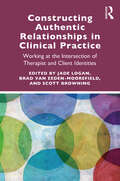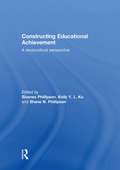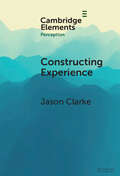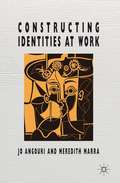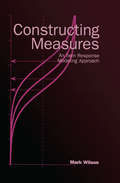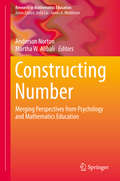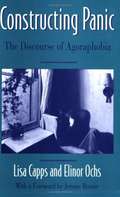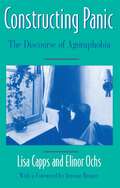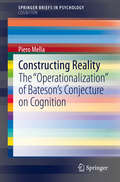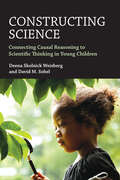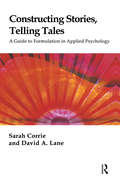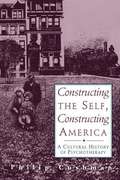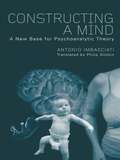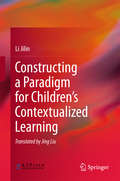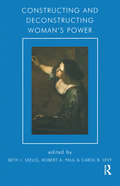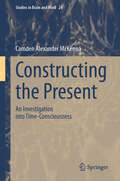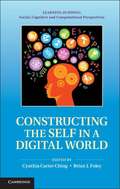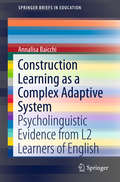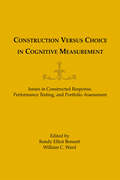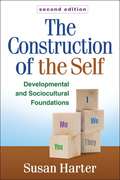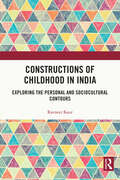- Table View
- List View
Constructing Authentic Relationships in Clinical Practice: Working at the Intersection of Therapist and Client Identities
by Jade LoganThis essential text explores the intersectionality of the self in therapeutic practice, bringing together theoretical foundations and practical implications to provide clear guidance for students and practitioners. Bringing together a collection of insightful and experienced clinicians, this book examines the ways in which intersectionality influences all phases of clinical and supervisory work, from outreach, assessment, and through to termination. Integrating research with clinical practice, chapters not only examine the theoretical, intersectional location of the self for the therapist, client, or supervisee, but they also consider how this social identity effects the therapeutic process and, crucially, work with clients. The book includes first-hand accounts, case studies, and reflections to demonstrate how interactions are influenced by gender, race, and sexuality, offering practical ideas about how to work intentionally and ethically with clients. Engaging, informative, and practical, this book is essential reading for students, supervisors, family, marriage, and couple therapists, and clinical social workers who want to work confidently with a range of clients, as well as clinical professionals interested in the role of intersectionality in their work.
Constructing Educational Achievement: A sociocultural perspective
by Shane N. Phillipson Sivanes Phillipson Kelly Y. L. KuInternational interest focuses on why pupils from East-Asia tend to outperform pupils from the West and scholars have proposed a number of possible explanations to account for these international trends. Using Vygotsky's theory (1978) as a conceptual framework to "construct" school achievement, this book puts forward culturally relevant context for understanding developmental aspects of children’s school achievement and their implication to classroom practice and education progress. Converging the two important lines of inquiry – the child factor and the sociocultural factor – this book showcases evidence-based scholarly works from across the globe that shed light on causes of academic achievement in different contexts. The book brings together eminent scholars from early childhood, primary education, secondary and vocational education who expertly capture the vitality of development and processes of specific child factors and their interaction with their environment that explain their school achievement. Foregrounded in the five planes of cultural historical, institutional, social, personal and mental, the research explain how children think, learn and form the will to perform amidst the changing social and family environment, and challenging school and educational environment.
Constructing Experience: Expectation and Attention in Perception (Elements in Perception)
by Jason ClarkeThis Element examines the influence of expectation and attention on conscious perception. It explores the debate on whether attention is necessary for conscious perception by presenting empirical evidence from studies on inattentional blindness, change blindness, and the attentional blink. While the evidence strongly suggests that attention is necessary for conscious perception, other research has shown that expectation can shape perception, sometimes leading to illusory experiences where predicted stimuli are perceived despite their absence. This phenomenon, termed 'expectation awareness', suggests that attention may not be necessary for all conscious experiences. These findings are explored within the predictive processing framework, where the brain is characterized as a prediction engine, continuously updating its internal models to minimize prediction errors. Integrating findings from psychology, neuroscience, and cognitive science, this Element provides a predictive processing model of how attention and expectation construct perceptual reality. It also discusses clinical and theoretical implications and suggests future research.
Constructing Identities at Work
by Jo Angouri Meredith MarraThrough language we show who we are and where we belong. In the workplace context this includes the way we construct ourselves as the team leader, meeting chair, a good colleague, the judge, a teacher orresearcher. Constructing Identities at Work presents cutting edge research on the process of identity construction in professional and institutional contexts, from corporate workplaces, to courtrooms, classrooms, and academia. The authors illustrate the range of foci, methodologies and approaches prevalent in the newly established field of workplace discourse, demonstrating how interactants do identity work and how identity is 'indexed' (often in subtle ways) in workplace discourse. Moving beyond unhelpful static universalities about how all women, all English-speakers, or all old people behave linguistically, each of the authors emphasises the contextualised nature of our everyday lives and the ways in which we negotiate and renegotiate our emerging identities with others. Among the chapters there are examples of a range of different theoretical approaches to identity in linguistics, from the prevalent social constructionist lens to the micro-level detail accessible through Conversation Analysis, and the quantitative analysis offered by corpus linguistics.
Constructing Measures: An Item Response Modeling Approach
by Mark WilsonConstructing Measures introduces a way to understand the advantages and disadvantages of measurement instruments, how to use such instruments, and how to apply these methods to develop new instruments or adapt old ones. The book is organized around the steps taken while constructing an instrument. It opens with a summary of the constructive steps involved. Each step is then expanded on in the next four chapters. These chapters develop the "building blocks" that make up an instrument--the construct map, the design plan for the items, the outcome space, and the statistical measurement model. The next three chapters focus on quality control. They rely heavily on the calibrated construct map and review how to check if scores are operating consistently and how to evaluate the reliability and validity evidence. The book introduces a variety of item formats, including multiple-choice, open-ended, and performance items; projects; portfolios; Likert and Guttman items; behavioral observations; and interview protocols.Each chapter includes an overview of the key concepts, related resources for further investigation and exercises and activities. Some chapters feature appendices that describe parts of the instrument development process in more detail, numerical manipulations used in the text, and/or data results. A variety of examples from the behavioral and social sciences and education including achievement and performance testing; attitude measures; health measures, and general sociological scales, demonstrate the application of the material. An accompanying CD features control files, output, and a data set to allow readers to compute the text's exercises and create new analyses and case archives based on the book's examples so the reader can work through the entire development of an instrument.Constructing Measures is an ideal text or supplement in courses on item, test, or instrument development, measurement, item response theory, or rasch analysis taught in a variety of departments including education and psychology. The book also appeals to those who develop instruments, including industrial/organizational, educational, and school psychologists, health outcomes researchers, program evaluators, and sociological measurers. Knowledge of basic descriptive statistics and elementary regression is recommended.
Constructing Measures: An Item Response Modeling Approach
by Mark WilsonConstructing Measures introduces a way to understand the advantages and disadvantages of measurement instruments. It explains the ways to use such instruments, and how to apply these methods to develop new instruments or adapt old ones, based on item response modeling and construct references. Now in its second edition, this book focuses on the steps taken while constructing an instrument, and breaks down the "building blocks" that make up an instrument—the construct map, the design plan for the items, the outcome space, and the statistical measurement model. The material covers a variety of item formats, including multiple-choice, open-ended, and performance items, projects, portfolios, Likert and Guttman items, behavioral observations, and interview protocols. Each chapter includes an overview of the key concepts, related resources for further investigation, and exercises and activities. A variety of examples from the behavioral and social sciences and education—including achievement and performance testing, attitude measures, health measures, and general sociological scales—demonstrate the application of the material. New to this edition are additional example contexts including a cognitive/achievement example, an attitude example, and a behavioral example and new concentrations on specific measurement issues and practices such as standard-setting, computer-delivery and reporting, and going beyond the Likert response format. Constructing Measures is an invaluable text for undergraduate and graduate courses on item, test, or instrument development; measurement; item response theory; or Rasch analysis taught in a variety of departments, including education, statistics, and psychology. The book also appeals to practitioners who develop instruments, including industrial/organizational, educational, and school psychologists; health outcomes researchers; program evaluators; and sociological measurers.
Constructing Number: Merging Perspectives From Psychology And Mathematics Education (Research In Mathematics Education Ser.)
by Anderson Norton Martha W. AlibaliThe book synergizes research on number across two disciplines—mathematics education and psychology. The underlying problem the book addresses is how the brain constructs number. The opening chapter frames the problem in terms of children’s activity, including mental and physical actions. Subsequent chapters are organized into sections that address specific domains of number: natural numbers, fractions, and integers. Chapters within each section address ways that children build upon biological primitives (e.g., subitizing) and prior constructs (e.g., counting sequences) to construct number. The book relies on co-authored chapters and commentaries at the end of each section to create dialogue between junior faculty and senior researchers, as well as between psychologists and mathematics educators. The final chapter brings this work together around the framework of children’s activity and additional themes that arise in the collective work. The book is aimed to appeal to mathematics educators, mathematics teacher educators, mathematics education researchers, educational psychologists, cognitive psychologists, and developmental psychologists.
Constructing Pain: Historical, psychological and critical perspectives (Critical Approaches to Health)
by Robert KugelmannEveryone experiences pain, whether it’s emotional or physical, chronic or acute. Pain is part of what it means to be human, and so an understanding of how we relate to it as individuals - as well as cultures and societies - is fundamental to who we are. In this important new book, the first in Routledge’s new Critical Approaches to Health series, Robert Kugelmann provides an accessible and insightful overview of how the concept of pain has been understood historically, psychologically, and anthropologically. Charting changes in how, after the development of modern painkillers, pain became a problem that could be solved, the book articulates how the possibilities for living with pain have changed over the last two hundred years. Incorporating research conducted by the author himself, the book provides both a holistic conception of pain and an understanding of what it means to people experiencing it today. Including critical reflections in each chapter, Constructing Pain offers a comprehensive and enlightening treatment of an important issue to us all and will be fascinating reading for students and researchers within health psychology, healthcare, and nursing.
Constructing Panic: The Discourse of Agoraphobia
by Elinor Ochs Lisa CappsMeg Logan has not been farther than two miles from home in six years. She has agoraphobia, a debilitating anxiety disorder that entraps its sufferers in the fear of leaving safe havens such as home. Paradoxically, while at this safe haven, agoraphobics spend much of their time ruminating over past panic experiences and imagining similar hypothetical situations. In doing so, they create a narrative that both describes their experience and locks them into it. Constructing Panic offers an unprecedented analysis of one patient's experience of agoraphobia. In this novel interdisciplinary collaboration between a clinical psychologist and a linguist, the authors probe Meg's stories for constructions of emotions, actions, and events. They illustrate how Meg uses grammar and narrative structure to create and recreate emotional experiences that maintain her agoraphobic identity. In this work Capps and Ochs propose a startling new view of agoraphobia as a communicative disorder. Constructing Panic opens up the largely overlooked potential for linguistic and narrative analysis by revealing the roots of panic and by offering a unique framework for therapeutic intervention. Readers will find in these pages hope for managing panic through careful attention to how we tell the story of our lives.
Constructing Panic: The Discourse of Agoraphobia
by Elinor Ochs Lisa CappsMeg Logan has not been farther than two miles from home in six years. She has agoraphobia, a debilitating anxiety disorder that entraps its sufferers in the fear of leaving safe havens such as home. Paradoxically, while at this safe haven, agoraphobics spend much of their time ruminating over past panic experiences and imagining similar hypothetical situations. In doing so, they create a narrative that both describes their experience and locks them into it. Constructing Panic offers an unprecedented analysis of one patient's experience of agoraphobia. In this novel interdisciplinary collaboration between a clinical psychologist and a linguist, the authors probe Meg's stories for constructions of emotions, actions, and events. They illustrate how Meg uses grammar and narrative structure to create and recreate emotional experiences that maintain her agoraphobic identity. In this work Capps and Ochs propose a startling new view of agoraphobia as a communicative disorder. Constructing Panic opens up the largely overlooked potential for linguistic and narrative analysis by revealing the roots of panic and by offering a unique framework for therapeutic intervention. Readers will find in these pages hope for managing panic through careful attention to how we tell the story of our lives.
Constructing Reality: The "Operationalization" of Bateson’s Conjecture on Cognition (SpringerBriefs in Psychology)
by Piero MellaThis brief presents an overview of Gregory Bateson’s Constructivist method of Cognition. Bateson proposes a theory of cognition that is based on the abstract notion of difference that the mind distinguishes and perceives and represents information that constitutes and separates how different states are ordered, grouped, and classified. Bateson, however, does not clearly indicate how a cognitive system can develop a knowledge of reality from the perception of these differences. This book seeks to offer a scientific approach to Constructivism. Using Bateson’s hypothesis, chapters discuss how our mind distinguishes and elaborates differences, allowing us to form perceptions of objects, and how these objects can be described and compared. Chapters also discuss how from differences, it is possible to construct concepts or ideas of how these can be defined and how to derive from these differences the meanings of the signs used for the structuring of languages. The brief offers a coherent structure of propositions that form an interpretative theory of the modus operandi of the human mind, which will be useful not only in shedding light on our cognitive processes, but also in laying the formal groundwork for artificial intelligence. Constructing Reality is a must-have resource for researchers and students of the cognitive sciences, as well as education sciences, and researchers and scholars of artificial intelligence, learning theory, and intelligent automata programming.
Constructing Science: Connecting Causal Reasoning to Scientific Thinking in Young Children
by David M. Sobel Deena Skolnick WeisbergAn examination of children&’s causal reasoning capacities and how those capacities serve as the foundation of their scientific thinking.Young children have remarkable capacities for causal reasoning, which are part of the foundation of their scientific thinking abilities. In Constructing Science, Deena Weisberg and David Sobel trace the ways that young children&’s sophisticated causal reasoning abilities combine with other cognitive, metacognitive, and social factors to develop into a more mature set of scientific thinking abilities. Conceptualizing scientific thinking as the suite of skills that allows people to generate hypotheses, solve problems, and explain aspects of the world, Weisberg and Sobel argue that understanding how this capacity develops can offer insights into how we can become a more scientifically literate society.Investigating the development of causal reasoning and how it sets the stage for scientific thinking in the elementary school years and beyond, Weisberg and Sobel outline a framework for understanding how children represent and learn causal knowledge and identify key variables that differ between causal reasoning and scientific thinking. They present empirical studies suggesting ways to bridge the gap between causal reasoning and scientific thinking, focusing on two factors: contextualization and metacognitive thinking abilities. Finally, they examine children&’s explicit understanding of such concepts as science, learning, play, and teaching.
Constructing Stories, Telling Tales: A Guide to Formulation in Applied Psychology
by Sarah Corrie David A. LaneFormulation remains one of the most important activities that those using psychological approaches undertake as part of their work. Arguably, however, formulation is an activity that remains poorly understood. In a current climate demanding quick fix solutions there is a tendency, which the authors refuse, towards over-simplification. Instead this book sets out to explore the challenging complexity of psychological formulation. By drawing on a wide range of sources from psychology and the arts the authors find ways to honour the stories clients tell yet offer key psychological insights to facilitate change. They provide a clear guide to enable the reader to think about the purpose of their work with clients, the perspectives which inform it and the process used to ensure effective outcomes. The chapters, supported by exercises on key issues, examine key debates on the role of formulation in professional practice, a framework for developing a systematic approach to formulation and a detailed account of the purpose, perspective and process of formulation.
Constructing The Self, Constructing America: A Cultural History Of Psychotherapy
by Philip CushmanIn this ground-breaking cultural history of psychotherapy, historian and psychologist Philip Cushman shows how the development of modern psychotherapy is inextricably intertwined with that of the United States and how it has changed the way Americans view events and themselves. By tracing our various definitions of the self throughout history, Cushman reveals that psychotherapy is very much a product of a particular time and place--and that it has been fundamentally complicit in creating many of the ills it seeks to assuage.
Constructing a Mind: A New Base for Psychoanalytic Theory
by Antonio ImbasciatiCan the Protomental System provide a new foundation for psychoanalytic theory? Constructing a Mind draws on psychoanalytic theories of mind and recent developments in cognitive science to present the Protomental System, a new and original explanatory theory of the development of the human mind. This book aims to move psychoanalytic theory away from its origins in Freud's theory, towards a model which gives priority to cognition and memory. This, Antonio Imbasciati argues, will make possible a successful and productive integration of psychoanalysis with other areas of psychology. Subjects covered include: The mind as an information-processing system Constructing the system: from fetus to baby, child, and finally adult The caregiver relationship as a decoding system for information processing The paranoid-schizoid metabolism of information Memory of functions and memory traces of affects Internal information generated by the system The depressive position and learning to know Reparation and thought. This thoughtful and thorough account of cognitive development provides a conceptual framework that succeeds in making some of the more complex areas of psychoanalytic theory more intelligible. Constructing a Mind will be of great interest to psychoanalysts, psychotherapists and cognitive psychologists, especially those with an interest in neuropsychology and neonatal development.
Constructing a Paradigm for Children’s Contextualized Learning
by Li JilinThis book focuses on summarizing four elements from the classic Chinese literary theory: truth, beauty, emotion and imagination. Based on the latest findings from learning sciences and brain science, it elaborates on the reasons for creating contexts in language teaching. It also shows how the aesthetical theories can be used to nurture contextualized instruction and presents six major approaches for creating contexts: creating contexts with real objects, representing contexts with pictures, evoking contexts with music, experiencing contexts with acting, unfolding contexts with real life, and describing contexts with languages. The author is a practitioner with over 30 years of practical research experience and all their studies are discussed in this book.
Constructing and Deconstructing Woman's Power
by Robert A. Paul Beth J. Seelig Carol B. LevyConstructing and Deconstructing Woman's Power explores power and gender issues from a variety of psychoanalytic, as well as social, cultural and philosophical perspectives. The first three papers examine the complex notion of external and internal glass ceiling brought to life by clear and illustrative clinical vignettes. The creation of life, a uniquely female power, is subsequently considered in two fascinating papers exploring motherhood and the conflicts it brings. The development and expression of feminine creativity more generally is further examined in two unique studies. The final three essays address men's relation to women and their power.
Constructing the Present: An Investigation into Time-Consciousness (Studies in Brain and Mind #24)
by Camden Alexander McKennaConstructing the Present: An Investigation into Time-Consciousness investigates what time is like for us as subjects and answers the question of how our experiential present comes to be. While addressing a variety of outstanding debates in the field, the book proposes that our temporal phenomenology is best understood as transcending traditional forms of analysis. The book ultimately concludes that time is not something we experience, but rather the way we construct our experience of the world. In the spirit of William James, McKenna suggests that the present occupies a window of time known as the &“specious present.&” McKenna claims that the duration of this subjective window is determined by the real temporal properties of experience, but also that experiential events are, as Edmund Husserl believed, temporally directed to varying degrees and in nested fashion in a way that affects their particular qualitative character. This specific proposal is called ERA: the Extensional-Retentional Analysis of temporal phenomenology. Besides doing justice to our temporal phenomenology, McKenna&’s overall position aligns with contemporary predictive approaches to the cognitive architecture of the mind. This exciting new way of thinking sees the brain as a predictive engine whose ongoing activities construct our rich subjective experiences. Taking inspiration from this movement, Constructing the Present introduces a complementary position called Temporality as Iterative Expectation Revision (or TIER). According to TIER, temporal phenomenology results from predictive activities of the brain occurring throughout an integrated multilevel cognitive processing hierarchy. Such a system is sensitive to the ongoing flux of environmental stimuli while retaining prior expectations and constantly updating our experiences probabilistically to ensure survival. The actual activity of this ongoing process, rather than its content, gives rise to the felt present, which is continuously constructed anew. Constructing the Present: An Investigation into Time-Consciousness functions as a scholarly defense of a provocative, plausible, and cohesive set of theses, while also confronting numerous adjacent philosophical issues along the way. By approaching the subject from the standpoint of empirically informed philosophy of mind, the present work fills a significant gap in the literature. The book should appeal especially to philosophically inclined researchers and students interested in cognitive science, psychology, and neuroscience, as well as philosophy of mind.
Constructing the Self in a Digital World
by Cynthia Carter Ching Brian J. FoleyIt has become popular in recent years to talk about 'identity' as an aspect of engagement with technology - in virtual environments, in games, in social media and in our increasingly digital world. But what do we mean by identity and how do our theories and assumptions about identity affect the kinds of questions we ask about its relationship to technology and learning? Constructing the Self in a Digital World takes up this question explicitly, bringing together authors working from different models of identity but all examining the role of technology in the learning and lives of children and youth.
Constructing the Sexual Crucible: An Integration of Sexual and Marital Therapy
by David SchnarchBy integrating individual, sexual and marital therapies, this study attempts to provide a fresh look at the nature of intimacy and the diverse barriers to eroticism in marriage. The author refutes the common focus on sexual technique, calling instead for an emphasis on sexual potential.
Construction Learning as a Complex Adaptive System: Psycholinguistic Evidence from L2 Learners of English (SpringerBriefs in Education)
by Annalisa BaicchiThis book presents the current state of the art on Construction Grammar models and usage-based language learning research. It reports on three psycholinguistic experiments conducted with the participation of university-level Italian learners of English, whose second language proficiency corresponds to levels B1 and B2 of the 'Common European Framework of Reference for Languages' (CEFR). This empirical research on the role of constructions in the facilitation of language learning contributes to assessing how bilinguals deal with L2 constructions in the light of sentence-sorting, sentence-elicitation, and sentence-completion tasks. Divided into two parts, the book first introduces the main theoretical prerequisites and then reports on the experimental studies. It provides a comprehensive review of the current research in a range of disciplines, including complexity theories, cognitive semantics, construction grammars, usage-based linguistics, and language learning.
Construction Versus Choice in Cognitive Measurement: Issues in Constructed Response, Performance Testing, and Portfolio Assessment
by William C. Ward Randy Elliot BennettThis book brings together psychometric, cognitive science, policy, and content domain perspectives on new approaches to educational assessment -- in particular, constructed response, performance testing, and portfolio assessment. These new assessment approaches -- a full range of alternatives to traditional multiple-choice tests -- are useful in all types of large-scale testing programs, including educational admissions, school accountability, and placement. This book's multi-disciplinary perspective identifies the potential advantages and pitfalls of these new assessment forms, as well as the critical research questions that must be addressed if these assessment methods are to benefit education.
Construction of the Self, Second Edition
by Susan Harter William M. BukowskiAn important work from a leading scholar, this book explores self-development from early childhood to adulthood. Susan Harter traces the normative stages that define the emergence of many self-processes, including self-esteem. She also addresses individual differences and societal influences on self-development. Presenting pioneering empirical research, Harter shows that increasingly mature features of the self have both benefits and liabilities for psychological adjustment. The book highlights the causes and consequences of different types of self-representations, including those that are unrealistically negative or positive. New to This Edition Reflects more than a decade of conceptual, empirical, and methodological advances. Provides a broader sociocultural framework for understanding self development. Chapters on emerging adulthood, self-esteem and physical appearance, self-processes in the classroom, motivation, cross-cultural issues, and the quest for authenticity. Expanded chapters on childhood, adolescence, and the self-conscious emotions, including humiliation. Increased attention to the liabilities of our contemporary preoccupation with the self.
Constructions and the Analytic Field: History, Scenes and Destiny (The New Library of Psychoanalysis)
by Domenico ChianeseConstructions and the Analytic Field questions the relationship between psychoanalysis, history and literature. Does the analyst help the analysand construct a narrative, or is their task more of a historical reconstruction? In seeking to answer this question, Domenico Chianese examines Freud's writing, beginning with 'Constructions in Analysis' and ending in 'Moses and Monotheism', as well as the impressions of analytic method reflected in contemporary writers such as Thomas Mann, and historical writings from both sides of the Atlantic. Drawing on vivid and persuasive clinical examples, he argues that psychoanalysis creates a 'scenic space' between analysand and analyst, a theatrical space wherein the cast of the patient's interior world enter and exit from the scene. Drawing on the rich Italian psychoanalytic tradition, this original approach to the analytic field will be of interest to psychoanalysts, historians and literary experts.
Constructions of Childhood in India: Exploring the Personal and Sociocultural Contours
by Ravneet KaurThis book explores the dominant constructions of childhood as perceived by children and adults in contemporary Indian society. It unveils the everyday lived experiences of children within family life to explain the meaning of childhood and the position of children as social groups. Based on detailed qualitative study, this volume discusses the themes and issues that impact dominant constructions of childhood. It establishes childhood as a structurally constructed category and sheds light on how key social differences influence the diverse experiences of childhood. The book critically examines how children, as social actors, contribute to the structural space of childhood through the recognition of their own experiences, voices, and ways of interpretations. Further, it also compares and analyses childhoods of today with those of the past generations. Engagingly written and nuanced, the book will be of great interest to teachers and students of education, childhood studies, elementary education, sociology of education and social psychology. It will also be useful for teachers of teacher training institutions, policymakers, educationalists, education professionals, parents and researchers working with children and childhood studies.
